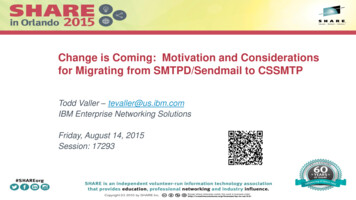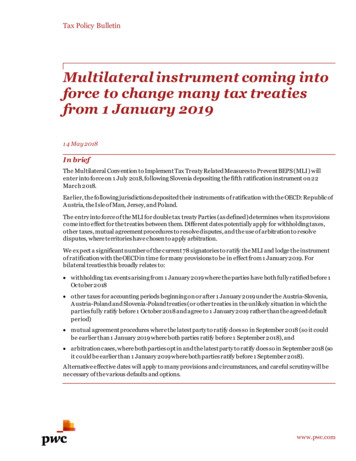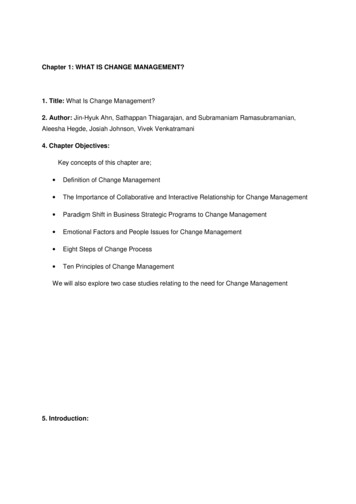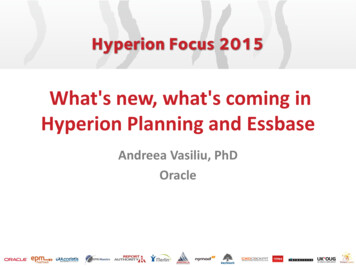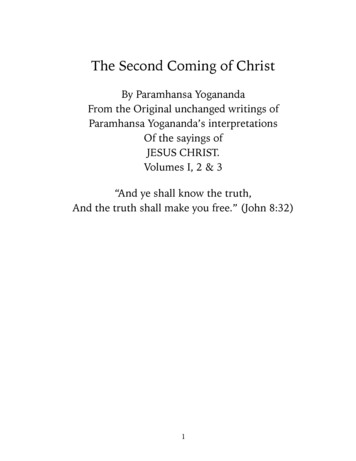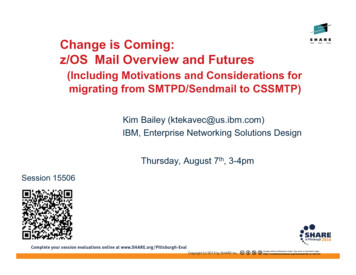
Transcription
Change is Coming:z/OS Mail Overview and Futures(Including Motivations and Considerations formigrating from SMTPD/Sendmail to CSSMTP)Kim Bailey (ktekavec@us.ibm.com)IBM, Enterprise Networking Solutions DesignThursday, August 7th, 3-4pmSession 15506InsertCustomSessionQR ifDesired.
Mail: We must have it! Internet Mail:– Life-line for communications– Critical for business Most have no concern for how it is transported through theinternet and have no need to understand the details– It is just sent and received! Typically some administrator in the enterprise datacenterhas responsibility for the configuration and setup of mail Important changes are coming with z/OS Mail2
Agenda Quick review of Mail standards and terminology Overview of the major Mail transports on z/OS Discuss the changes that are coming for the Mailtransports on z/OS
Quickly.Brushing up on the Standards
Internet Mail Standards1. Internet mail is based upon a set of IETF standards. There areseveral, but a few are foundational:–RFC5321 (based upon RFC’s 2821 and 821)- defines the Simple Mail TransferProtocol (SMTP). TCP-based protocol (reliable). Defines the standards forcommunication between the mail client and server.–RFC5322 (based upon RFC’s 2822 and 822)- defines the format oftext messages exchanged.–RFC6409 – Message Submission Protocol which defines the processthat extend the MTA (Mail Transport Agent) role for message submissions fromMUAs (Mail User Agents). Focus on more validation where mail is submitted.From: yourboss@work.comTo: you@work.comSubject: Good job todayYou are a great worker!Envelope (RFC5321)Contents (RFC5322)
Mail Transport Applications and Terminology2.Several types of “agents” play roles in the submission, transport, and delivery of mail.These implement the mail standards (standards define these): Mail Transfer Agent (MTA):– Performs the SMTP protocol in both client and server roles. Listens on well-knownport 25.– Responsible for transport and delivery of mail. Typically acts as a relay.– Uses Domain Name Server (DNS) to resolve recipients and then sends to next hop MTA. Message Submission Agent (MSA):– MSA defines a more specific role for the MTA. The MSA performs in the SMTPserver role where the mail message enters the systems (from the MUA).– MSA Listens on port 587 for incoming connections from the SMTP client .– Once the MSA receives the message, then the host will typically become MTAperforming delivery or performing as an SMTP client to relay. Mail User Agent (MUA):– Program used to send and read mail (Lotus Notes, Outlook, Thunderbird).– May include or invoke an SMTP client which then connects to an MSA to send a message.– Typically uses the POP protocol as a client to receive email from the host running the POPserver where the user’s mailbox resides. Mail Delivery Agent (MDA):– At the final destination (target mailbox), the MTA invokes a local programcalled the “delivery agent” to deliver the message to the recipient’s mailbox.
How does your message get to the final destination(s)?From: sarah@miami.comTo: sue@dallas.com,cc: kay@austin.comSubject: Great work1.You get a raise!Thanks, SarahUser (Sarah) constructs an email message usingan MUA like Lotus Notes The message is sent to one or more recipients (To: Sue inDallas cc: Kay in Austin) The SMTP client with her MUA, connects to port 587 on thelistening Message Submission Agent (MSA) to sent the mailMTAMUAMiami domainSarahMSAsmtppopListenson port 587(Relay)MTADallas domain(Relay)MTA,MDAListenson port 25smtppopListenson port 25MTA,MDA,POPsmtp2.The MSA then acts as an SMTP client connects to one or more Mail Transfer Agents(Relay server MTA’s) using the SMTP protocol to transport the envelope to the destination mailboxes Hop by Hop, SMTP client MTA to server MTA connection SuepopAustin domainThe Domain Name System (DNS) is a critical component since it assists the MSA/MTA’s with determiningthe next hop MTA. Using MX lookup.3.Finally the mail is delivered to the users’ mailboxes (Sue and Kim)4.The end user then uses an MUA which uses the POP (Post POffice Protocol) to access the mailboxKay
IBM’s z/OS SMTP-based Mail Transport ApplicationsSendmailSMTPDCSSMTP
Sendmail Ported from the popular sendmail.org, today known as “Open SourceSendmail”.– z/OS Comm Server ported at the 8.12.1 level (2001) and years from current Robust mail agent support for transporting mail messages– Implements Internet Standards for Internet mail– Sendmail supports most of the mail “agent” roles (MSA, MTA). Its “role” depends upon theoptions with which it is started. The sendmail command can be used to send an email message, performing as an SMTPclient communicating to an SMTP server . Sendmail daemon can be used to listen on port 587 (MSA) or port 25 (MTA Relay).– Supports other features like mail filtering (Milter API), TLS/SSL Sendmail typically uses the OpenSSL library for TLS/SSL, but on z/OS, System SSL isused to secure the SMTP connection Sendmail is primarily used to send mail from z/OS using the simple sendmail clientprogram; however, it can be used to deliver mail to z/OS Unix mailboxes Ex: sendmail –t mymsg.txt from unix shell Robustness of Sendmail makes it very powerful functionally, but very complicated toconfigure and exploit those functions
SMTPD NJE Mail Gateway Application1.Performs as a gateway for sending mail messages from the local or NJE host(JES) to the TCP/IP network using the SMTP protocol–Batch jobs or TSO users using SMTPNote allocate sysout datasets containingone or more mail messages to spool. ––2.The destination for the dataset is the SMTPD application defined as an external writer.Each message contains the SMTP protocol commands along with the mail body.SMTPD reads each sysout dataset and processes each mail messageFunctions as an MTA in the SMTP client role to send the message from z/OSPerforms as a full Mail Transfer Agent (MTA) acting as both an SMTP client andserver– Listens on port 25, accepting connections from smtp clients which may beremote or local to z/OS (such as the z/OS Sendmail client) Receives mail to z/OS for delivery to TSO users or for relaying/forwardingto the next hop MTA (Typically will use DNS to find the next hop MTA) Requires z/OS DASD to store while processing messages until deliverySMTPD is a very old application and has many shortcomings, but has beenthe primary mail transport on z/OS
SMTPD Role: NJE GatewayBatch JobEHLOMAIL FROM: me@ibm.comRCPT TO: kay@xxx.comRCPT TO: sue@xxx.comDATADate: Thur, 26 Mar 99 From: xx@xxx.comTo: kay@xxx.comCc: sue@xxx.comSubject: account updatesoverdraftQUITSMTP protocolcommandsin blue textbodyxxx domain1.SMTPDSPOOL--Read sysoutdataset for ext writer Process Copy from spoolto temp datasetskaysueCopytemp messagedatasets2.smtp protocol connections3.4.-Resolve-Send messageto next hop(smtp client)5.6.Once sent, cleanup tempdatasets
SMTPD Role: SMTP Relay with Sendmail ClientFrom: me@xxx.comTo: kay@xxx.comCc: sue@xxx.comSubject: account updatesoverdraftMyApplicationsendmail –t msg.txt1. Note: MyApplication could berunning on z/OS or distributedSendmail smtp protocolconnectionSMTPD2.SMTP Server: Notice: Steps 3-6 are the samein this example and the previous. Note: SMTPD can’t send themessage, it will retry (steps 3-5)-Listen ( Port 25)3.Copytemp messagedatasetsxxx domainkaysue4.Send messageto next hop(smtp client)6.Once sent,cleanup tempdatasets5.smtp protocolconnections
SMTPDAging Transport; Significant Challenges to Modernize SMTPD’s aged implementation prevents enhancements for exploitation of keyrequirements– IPv6– TLS/SSL support for securing the SMTP connection Poor Performance– Designed to have heavy reliance on I/O stores all datasets from spool to disk; therefore,requires configuration of permanent storage (DASD) for message store (temporarydatasets).– Inefficient ,single-threaded runtime processing model – services spool, SMTP, andmessage store. Requires starting the VMCF and TNF subsystems Support for IETF Mail standards are not up to date No SMF record support to allow for auditing Operator commands are very not robust Does not use system translation services (iconv)
How to Addresss SMTPD Challenges? A critical mail transport on z/OS, especially with the NJE SMTP Gateway role Has many customer requirements for new/enhanced function, primarily for:– Improving performance– Support for newer Internet mail standards including support for TLS/SSL– Improving usability and management features Real inhibitors to updating SMTPD: Many design challenges to overcome Not cost-effective to rewrite since the application design is poor given the advancementsin system technology Real need to take action for an improved NJE SMTP Gateway and enterprise classMTA worthy of z/OS customers since mail is business critical Sendmail does not meet requirements to fully/efficiently replace
z/OS CSSMTP Mail ApplicationIntroduced in z/OS V1R11as strategic replacement forSMTPD NJE SMTP Client Gateway
CSSMTP NJE Mail Gateway Application Created to replace SMTPD and address many of its shortcomings Not a full “functional” replacement for SMTPD; however, supports keyfunctional requirements allowing most all z/OS customers a full and easymigrationLike SMTPD, CSSMTP performs as a gateway for sending mail messagesfrom the local or NJE host (JES) to the TCP/IP network using the SMTP protocol–––– z/OS batch applications allocate syout datasets to spool containing one or more mailmessages. The destination is the CSSMTP external writer.Each message contains the SMTP protocol commands along with the mail body.Each dataset is read and the mail messages are processedConnects as an SMTP client to an MTA that is a Relay (Smart Host) as the next hop. CSSMTP will not resolve each recipient in the mail message!Unlike SMTPD does not support full Mail Transfer Agent (MTA) capabilities in thatit does not support the server MTA role (ie. Does not perform as a listener )–Only performs as an SMTP client After the mail message is read from spool, performs the SMTP client role andconnects to a remote server MTA (could be local SMTPD or Sendmail) and sendsthe mail message SMTPD and CSSMTP can coexist as NJE SMTP Client Gateways!
CSSMTP as SMTP NJE Gateway Notes: Unlike SMTPD, CSSMTP will keep the dataset onthe spool until all messages are sent to the nexthop (or undeliverable)Batch JobEHLOMAIL FROM: me@ibm.comRCPT TO: kay@xxx.comRCPT TO: sue@xxx.comDATADate: Thur, 26 Mar 99 From: me@xxx.comTo: kay@xxx.comCc: sue@xxx.comSubject: account updatesoverdraftQUIT1.SMTP protocolcommandsin blue text No permanent storage required outside of spool,unless ExtendedRetry is required Queued to in Unix file system CSSMTP can perform long retry (LongRetry) ofup to five days without requiring additionalpermanent storagebodyAllocateto sysoutSPOOLCSSMTP--Read sysoutdataset forexternal writerNext HopMTAFinal DestinationMTA2.xxx domain-Process-Send message tonext hop MTAsmtp protocol connections
Migrating from SMTPD to CSSMTPDeep Dive into Functional Comparisons
Encourage Migration from SMTPD to CSSMTP CSSMTP does not support all features of SMTPD Design points targeted such that most users will migrate easily– Both applications can coexist. This can help with migration. Requires an administrator to read and understand requirements forconfiguration and setup. Refer to:– z/OS Communications Server IP Configuration Guide– z/OS Communications Server IP Configuration Reference The following slides provide a summary and comparison of function– CSSMTP provides superior function for sending mail– Also refer to z/OS Communications Server IP Configuration Guide, chapteron “Mail on z/OS”.
Mail Agent Roles ComparisonSMTPDvsCSSMTP The SMTPD NJE SMTP Gateway CSSMTP NJE SMTP Gateway SMTPD provides a full Mail TransferAgent (MTA) acting as both an SMTPclient and server: Provides MTA role as the SMTP clientsending to next hop MTA:– Client: Removes mail from spooldatasets and sends mail from z/OS– Server: Listens for incoming SMTPconnections ( ex: delivers to TSOusers) Provides forwarding to a next hop relay Does support lookup for eachrecipient– Client: Reads messages from spooldatasets and sends from z/OS– Server: Not supported. Does not listenfor SMTP connections Can’t receive undeliverablenotifications. Sender’s address shouldbe on another system. Provides “forwarding” role where requiresa next hop relay. Does not resolve recipients!
SMTP Protocol Commands and Processing Related to StandardsSMTPDvsCSSMTP Does not support latest Internet Mailstandards. Supports RFC821 andRFC822. Supports newer mail standardsRFC2821 and RFC2822.– Disallows source routing Lenient processing headers and body Stricter compliance with RFC2822. Cases where allows messages notin line with standards Supports delivery to TSO users. Supports both internet domainnames and userid%NJEdomain Provides support for header rewritetarget tso user to internet user Helps to ensure cleaner processingby next hops No support for delivery to TSO users. Only supports internet domain namesfor senders, recipients, and postmaster. No support for userid%NJEdomain No support for header rewrite
SMTP Protocol Commands and Processing Related to Standardscontinued SMTPD Support translation (EBCDIC toASCII) of messages withtranslation tables (library), butdoesn’t use ICONV(modernplatform translation services)vsCSSMTP Supports the ability to translateusing ICONV and to specify thecodepage to translate to USASCII).– SMTPD tables are notsupported. Supports ATSIGN configurationstatement. No support for ATSIGN configurationstatement. Use Codepage to performtranslation.
Application Performance and Ability to Ensure Message DeliverySMTPDvs Requires z/OS DASD (MVSdataset) to store message untilsent– Heavy I/O requirements– Tries to send until success oreventual failureCSSMTP No requirements for z/OS DASD– Efficient processing of messages inmemory and automatic quiescing of spoolprocessing when private storage is at75% utilization (could be due to slowtarget server) . APAR V1R12: PM92166– Messages remain on spool until sent (orfail)– If target servers unreachable, thenreading of spool is quiesced until aserver is available.– Support for “long”/“extended” retry wheretarget servers have resource issues. For“extended”, can define a message storein Unix file system allowing CSSMTP toremove datasets from spool. No support for message Checkpointing.If SMTPD is restarted, messages mustbe reprocessed. Supports message Checkpointing sothat if CSSMTP is restartedmessages are notreprocessed
Head to Head Performance Comparisons In performance comparisons sending 4000 emails– CSSMTP was 4.5 times faster than SMTPD– CSSMTP used half as much CPUCSSMTP
Securing Mail Transport and Who can Send MailSMTPDvs No support for security the SMTPconnection with TLS/SSL and nosupport for SMTP STARTTLS.– Unable to use AT-TLS Supports a Security ExitCSSMTP Support for securing the SMTPconnection with TLS/SSL. Support forRFC3207 ( SMTP STARTTLS)– Uses AT-TLS Supports a Security Exit with manyenhancements. SMTPD exits can migrate easily. Support for SECURE and RESTRICTconfiguration statements to restrict senders(mail from) and receivers (rcpt to) No SAF controls Provides a SERVAUTH SAF profile.CSSMTP will only read spool datasetswhere the user that allocated the dataset ispermitted to the SERVAUTH profile. No controls around the sender orrecipients in the message.
Systems Management and Miscellaneous FeaturesSMTPD Limited support for consolecommand displays No support for SMF records No Support for IPv6vsCSSMTP Robust console command supportfor displays and modify Robust support for SMF records Support for IPv6
Future and Strategyz/OS Mail Transports
z/OS Strategy for Mail Transports IBM has issued a formal Statement of Direction to removeSendmail and SMTPD from z/OS– Allow time for planning– CSSMTP is the strategic mail transport on z/OS Supports primary use cases for “majority” of z/OS customer IBM understands that there will be impacts to removing theseapplications since it is recognized that CSSMTP does notcurrently address all functional gaps– Require feedback from our users– Continue to gather information on severity of impact to business
February 14th Hardware (updates) announcement:Official IBM Statement of Direction:Removal of SMTPD NJE Mail Gateway and Sendmailmail transport from z/OS Communications Server:It is the intention of IBM to remove the Simple Mail Transport Protocol NetworkJob Entry (SMTPD NJE) Mail Gateway and Sendmail mail transports fromz/OS Communications Server in the future. If you use the SMTPD NJEGateway to send mail, IBM recommends you use the existing CSSMTP SMTPNJE Mail Gateway instead. CSSMTP provides significant functional andperformance improvements. The Sendmail client program can also be used tosend mail messages; a replacement function using CSSMTP as the SMTPtransport is planned. This function will be designed so that it does not requireapplication programming changes. No replacement function is planned in z/OSCommunications Server to support using SMTPD or Sendmail as a (SMTP)server for receiving mail for delivery to local TSO/E or z/OS UNIX SystemServices user mailboxes, or for forwarding mail to other bin/ssialias?infotype an&subtype ca&appname gpateam&supplier 897&letternum ENUS114-009
Impacts of Removing Sendmail and SMTPD Three major areas of consideration:1.Removes platform provided SMTP server (listener) support:–Products that use an smtp client on z/OS will be required to connect directly to a remotemail server (ex: mail server on zLinux) ––Ex: products using sendmail client, java mail, other product-embedded clientsUsers should consider use cases where functions use a local SMTP client may dependupon a local server for high availabilityIn the case of SMTPD, no support for delivery of mail to TSO users2. Sendmail command is an SMTP client used to send mail––Used by z/OS programs (tooling, scripts, program products) to sendmail andwould have serious impact if removedTypically connects to the sendmail or SMTPD server locally3. Migrating from SMTPD to CSSMTP in a production environment Don’t want to impact production mail processes. No easy way to test andensure production mail will be sent with CSSMTP.
Addressing Impact of Removing Sendmail and SMTPD Removing platform provided SMTP server and Sendmail daemon (listeners)support. Users may consider:– A mail server on zLinux or other off-platform solution– Vendor-provided solutions that could run on z/OS (requires more discussion) Sendmail command is an SMTP client used to send mail– Propose “replacement” sendmail command that would perform asa “thin gateway SMTP client”: Would “transparently” allocate the mail message to spool and thentransported with CSSMTP Applications using the sendmail client could function seemlessly. Would require some administrative changes to migrate to CSSMTP
Sendmail “Thin Gateway Client”sendmail –t mymsg1)Add SMTP commandsFrom:yourboss@work.comTo: you@work.comSubject: Good job todayGreat work!z/OSEHELOMail From: ktb@ibm.comRCPT To: bject: good job todayGreat work!.QUIT2)Sent to CSSMTP external writerSPOOLCSSMTP3)Sent to external MTAUsing (E)SMPT protocolMTA
Addressing Impact of Migrating SMTPD to CSSMTPKey Concern: “How to ensure my production mail workload will be processedsuccessfully with CCSMTP”?– No real way to perform a true test with production environment– Many users aren’t sure about all sources of mailIBM will address migration requirements with migration aids:– Allow CSSMTP to tolerate (ex: Toleration Mode Option) mail messages that maynot be compliant with IETF standards in cases where SMTPD would have processedthe
functional requirements allowing most all z/OS customers a full and easy migration Like SMTPD, CSSMTP performs as a gateway for sending mail messages from the local or NJE host (JES) to the TCP/IP network using the SMTP protocol – z/OS batch applications allocate syou
